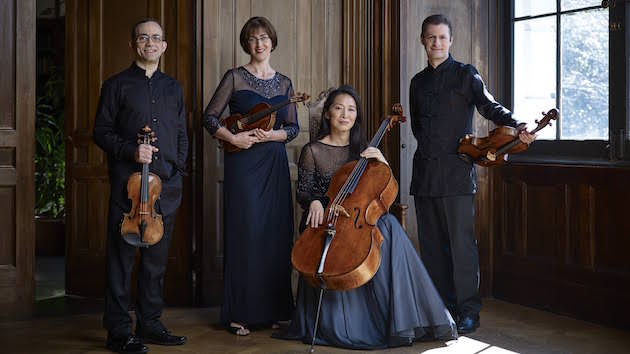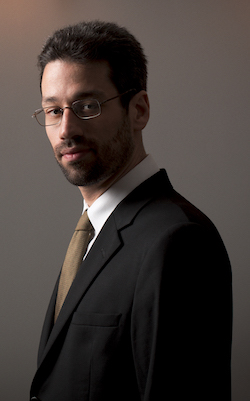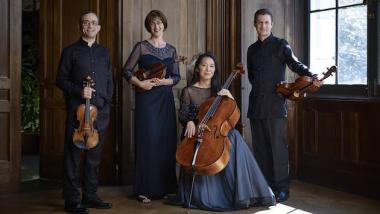
Maybe it was fitting that the highlight of Saturday’s program at the Herbst Theatre devoted to Beethoven’s “late style” came at the end of the evening. With their transfixingly shaped account of the 1827 String Quartet in F major, Op. 135, the composer’s final completed work, the players of the Brentano String Quartet brought a sense of hushed attentiveness to a piece that is not often regarded in the same company with the other soul-searching late quartets. The San Francisco Performances program note labeled it “the black sheep of this bunch.”
If the Op. 135 doesn’t pose the same kind of probing, existential questions that the propulsive Op. 131 or the monumental Grosse Fuge of Op. 133 do, there’s a kind of musing quest for serenity here that proved deeply affecting in the Brentano’s performance. From their quizzical inflection of the opening Allegretto to the minor-key intrusion and exultant climax of the final movement (marked “The difficult resolution” by the composer), thought and feeling, heartache and consolation were intuitively bound.
Striking right away and throughout was the taut but yielding phrasing. Violinists Mark Steinberg and Serena Canin, violist Misha Amory and cellist Nina Lee conversed in clipped but open-ended utterances. The slightly elongated silences between became as important and telling, in their way, as the notes themselves. A febrile sense of urgency, with Lee’s pithy playing leading the way, emerged in the first movement. The subsequent Vivace took on a furtive, almost guarded air.
The performance reached its high point in the spacious slow movement, rising from a murmurous opening that seemed to pry open the tonal and harmonic contours of this gorgeous, patient essay. Lee, once again, proved crucial in the late stages, as the cello spun out the long, low ground to set off Steinberg’s gently meandering violin line. The finale was deliberate, purposeful, and dramatic in its sudden minor-key darkening and dance-like rush toward the light.
“Late style,” as pianist Jonathan Biss remarked after intermission — and after he had played Beethoven’s last Piano Sonata, Op. 111 just before the break — is a complex issue. Citing Elgar’s Piano Quintet, Op. 84 as an example of “expansiveness” and Bach’s Art of the Fugue as a late turn toward “austerity,” Biss suggested that composers, as well as painters, writers, and other artists, often take radically different and often liberating paths as the end approaches. The Elgar and Bach works will be paired this Wednesday, October 19, in the second of four “late style” programs Biss is curating for San Francisco Performances. The other two evenings — one devoted to Schumann, Kurtág, Chopin, and Brahms and the other to an all-Schubert bill, follow on February 11, 2017 and March 17, 2017, respectively.

Biss, a reliably fine and deeply thoughtful performer, lived up to his reputation in the strange, haunting C minor sonata, a piece that unfolds in two highly contrasting movements. Biss took command of the combative opening movement with chords that both thundered ominously and seemed to splinter open transparently. He lingered over dissonances and gave the trills an almost brittle, hard-edged clarity. There was a remorseless fury to it all, suddenly brought up short by a dynamic downshift and an unsettling, almost reluctant ending.
The second movement, a set of variations on a tenderly idling theme, was something of a letdown. While Biss continued to interrogate the score, especially with an emphasis on the left hand, he short-changed some of the lyrical, cantabile qualities. It was often fascinating, turning from restraint to bluntness, but finally a few degrees less mysterious and transporting than it might have been.
The program opened with the composer’s Violin Sonata in G major, Op. 96. A “late style” piece largely on technical grounds — this 1812 work turned out to be the last in the genre Beethoven ever wrote — this duo sonata made the slightest impression of the night. Biss and Steinberg both did some fine work. The pianist gave the opening bars of the Adagio a chorale-like solemnity. Steinberg found an angular drive and energy, missing earlier on, in the second variation of the finale. But for considerable stretches of the piece, balance and proportion were lacking, with the violin often too tentative against Biss’ striding, assertive approach.
Things did settle well in that magnificent final movement, with its touching reminiscences of themes and moods from earlier on. Already, 15 years before his death, Beethoven had an instinct for looking back fondly and recalling where he’d been.

